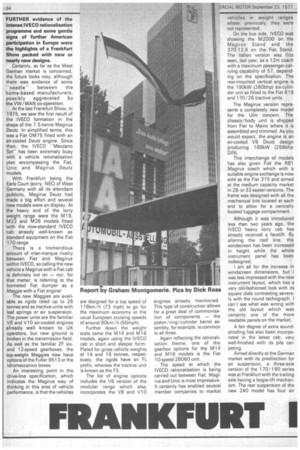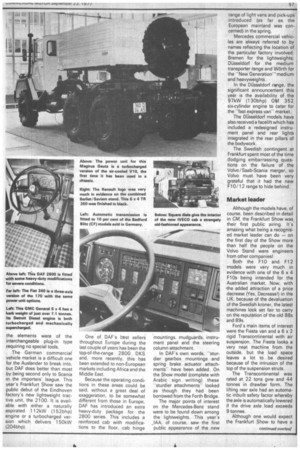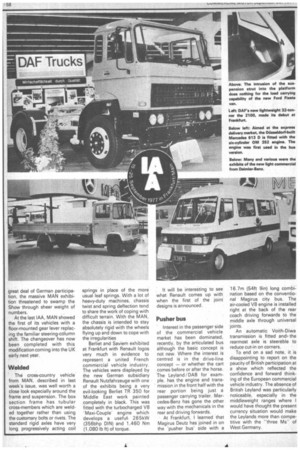FRANKFURT I /OM ON IVECO
Page 60

Page 61

Page 62

Page 63

Page 64

If you've noticed an error in this article please click here to report it so we can fix it.
FURTHER evidence of the intense IVECO rationalisation programme and some gentle signs of further American participation in Europe were the highlights of a Frankfurt Show packed with new or nearly new designs.
Certainly, as far as the West German market is concerned, the future looks rosy, although there was evidence of some -needlebetween the home-based manufacturers, possibly aggravated by the VW/ MAN co-operation.
At the last Frankfurt Show, in 1975, we saw the first result of the IVECO formation in the shape of the 7.5-tonne Magirus Deutz. In simplified terms, this was a Fiat 0M75 fitted with an air-cooled Deutz engine. Since then, the IVECO "Meceano Sethas been extremely busy with a vehicle rationalisation plan encompassing the Fiat, Unic and Magirus Deutz models.
With Frankfurt being the Earls Court (sorry, NEC) of West Germany with all its attendant publicity, Magirus Deutz had made a big effort and several new models were on display. At the heavy end of the lorry weight range were the M19, M22 and M26 models fitted with the now-standard IVECO cab already well-known as standard equipment on the Fiat 170 range.
There is a tremendous amount of inter-marque rivalry between Fiat and Magirus within IVECO, so calling the new vehicle a Magirus with a Fiat cab is definitely not on — nor, for that matter, is referring to the bonneted Fiat dumper as a Maggie with a Fiat engine!
The new Maggies are available as rigids rated up to 26 tonnes and as tractive units with leaf springs or air suspension. The power units are the familiar V8 and V10 air-cooled engines already well known to UK operators, but new ground is broken in the transmission field. As well as the familiar ZF sixand 12-speed gearboxes, the top-weight Maggies now have options of the Fuller 9513 or the ldromeccanico boxes.
An interesting point in the drive-line specification, which indicates the Magirus way of thinking in this area of vehicle performance, is that the vehicles are designed for a top speed of 118km/h (73 mph) to go for the maximum economy at the usual European cruising speeds of around 80km /h (50mph).
Further down the weight scale came the M14 and M16 models, again using the IVECO cab in short and sleeper form. Plated for gross vehicle weights of 14 and 16 tonnes, respectively, the rigids have an FL prefix, whereas the tractive unit is known as the FS.
The list of engine options includes the V6 version of the modular range which also incorporates the V8 and V10 engines already mentioned. This type of construction allows for a great deal of commonisation of components — the piston /ring /cylinder barrel assembly, for example, is common to all three.
Again reflecting the rationalisation theme, one of the gearbox options for the M14 and M16 models is the Fiat 10-speed 28060 unit.
The speed at which the IVECO rationalisation is being carried out between Fiat, Magirus and Unic is most impressive. It certainly has enabled several member companies to market vehicles in weight ranges where, previously, they were not represente.d.
On the bus side, IVECO was showing the M2000 on the Magirus Stand and the 370.12.6 on the Fiat Stand. The Italian version was first seen, last year, as a 12m coach with a maximum passenger-carrying capability of 57, depending on the specification. The rear-mounted vertical engine is the 190kW (260bhp) six-cylinder unit as fitted to the Fiat 619 and 170/26 tractive units.
The Magirus version represents a completely new model for the Ulm concern. The chassis/body unit is shipped from Fiat to Mainz where it is assembled and trimmed. As you would expect, the engine is an air-cooled V8 Deutz design producing 188kVV (256bhp DIN).
This interchange of models has also given Fiat the R81 Magirus coach which with a suitable engine exchange is now sold as the Fiat 315 and aimed at the medium capacity market in 28-or 32-seater versions. The frame was designed with all the mechanical bits located at each end to allow for a centrally located luggage compartment.
Although it was introduced less than two years ago, the IVECO heavy lorry cab has already received a facelift. By altering the roof line, the windscreen has been increased in height while the whole instrument panel has been redesigned.
I am all for the increase in windscreen dimensions, but I was less impressed with the new instrument layout, which has a very old-fashioned look with its square dials contrasting severely with the round tachograph. I can't see what was wrong with the old layout which was certainly one of the more readable panels on the market.
A fair degree of extra soundproofing has also been incorporated in the latest cab, very well-finished with its pile carpeting.
Aimed directly at the German market with its predilection for air suspension, a three-axle version of the 170/190 series was at Frankfurt with the trailing axle having a bogie-lift mechanism. The rear suspension of the new 240 model has four air bellows on the drive axle and two on the trailing with the air pressure regulated by load sensing valves. The facility for easy adjustment of the frame height makes the arrangement ideal for swop bodies.
European shows (with the very obvious exception of the UK contribution) are receiving more and more attention from the American lorry builders. This fact is made all the more interesting after the comments of MAN's managing director Otto Voisard, reported in CM a couple of weeks ago, where he suggested that the European
commercial vehicle manufacturers would be advised to look over their shoulders at American involvement in Europe. Frankfurt saw a classic case of "'trying the water" with the appearance of a couple of Kenworths.
The Kenworth C500 was a very robust-looking device with a typical mechanical package including a Cummins engine and a Fuller Roadranger gearbox. Extensive use of aluminium was evident in such areas as wheels, fuel tanks and the cab. The main structure of the normal control cab is in aluminium with the bonnet fabricated from glass fibre.
Representing the "Middle East Specialcategory was the Kenworth Transorient and, here again, the use of aluminium as a weight-saving technique was demonstrated. The Transorient is offered in two forms, the "standard" and the "long haul" with the latter on show in Germany. The long-haul version differs from the standard in that it features a refrigerator, cooking and washing facilities. This has become fairly commonplace in Europe with manufacturers competing in the long-distance Middle East type of market, but
the Kenworth differs in detail application as the washing! cooking unit can be slid under the single bunk out of the way.
The other obvious difference over its European counterparts concerns the cab structure with the extra roof section (plus window) to allow the driver to stand upright in the cab when changing clothes, for example.
Kenworth Lorries (the name is derived from the names of two principal shareholders in the original company, H. M. Kent and E. K. Worthington) are part of Paccar International which is involved in a fairly extensive investigation of the European market with particular interest being shown in Germany. Switzerland, Holland, France and Norway.
At the moment, the company's intentions towards the UK market are somewhat vague mainly because of price. Because the various Kenworth components are sourced directly from the United States, there is a cost penalty which Paccar representatives estimated would put the price of a Transorient at not far short of £40,000 in the UK.
Built on similar lines to the bonneted Kenworth C500 is the GMC General which had its first European airing at Frankfurt after its launch in America last year. The particular General on the GM /Opel Stand in Frankfurt was a 6x4 designed for artic operation despite the fact that Bedford marketing feels the machine has the most potential as an on/off-road tipper.
The power unit is the Detroit Diesel V8 engine as used in the European TM3800 from Bedford with the addition of a turbocharger. Talking about supercharging in relation to a two-stroke engine can get a bit complicated because of the mechanical supercharger, often used for scavenging. So the Detroit has, in effect, two superchargers: one, positively driven to scavenge the cylinders and a second which is a conventional turbocharger. By means of this double ''outside assistance" the 8V-92 TT "Fuel Squeezer" develops no less than 280 kW (375 bhp DIN) at 1,950 rpm with an equally impressive maximum torque figure of 1,646 Nm (1,212 lb ft) at 1,400 rpm. The Frankfurt General had a wheelbase of 5.39m (17ft 8in) and a gvw of 22.2 tonnes (21.8 tons). Towing a trailer gives a gross weight potential of 36.3 tonnes (35.7 tons), although Bedford claims that the in-built design capability of the General is as high as 58 tonnes (57 tons) according to application and conditions. The use of aluminium has kept the kerb weight down to just over 7.1 tonnes.
Some interesting features of the General, aimed at ease of servicing, included a circuit breaker panel in place of the more usual fuse box where all the elements were of the interchangeable plug-in type requiring no special tools.
The German commercial vehicle market is a difficult one for the Auslander to break into, but DAF doesbetter than most by being second only to Scania in the importers league. This year's Frankfurt Show saw the public debut of the Eindhoven factory's new lightweight tractive unit, the 2100. It is available with either a naturally aspirated 112kW (152bhp) engine or a turbocharged version which delivers 150kW (204bhp).
One of DAF's best sellers throughout Europe during the last couple of years has been the top-of-the-range 2800 DKS and, more recently, this has been extended to non-European markets including Africa and the Middle East.
Because the operating conditions in these areas could be said, without a great deal of exaggeration, to be somewhat different from those in Europe, DAF has introduced an extra heavy-duty package for the 2800 series. This includes a reinforced cab with modifications to the floor, cab hinge mountings, mudguards, instrument panel and the steering column attachment.
In DAF's own words, "sturdier gearbox mountings and spring brake actuator attachments" have been added. On the Show model (complete with Arabic sign writing) these "sturdier attachments" looked as though they had been borrowed from the Forth Bridge.
The major points of interest on the Mercedes-Benz stand were to be found down among the lightweights. This year's _IAA, of course, saw the first public appearance of the new range of light vans and pick-ups introduced (as far as the European mainland was concerned) in the spring.
Mercedes commercial vehicles are always referred to by names reflecting the location of the particular factory involved: Bremen for the lightweights; DLisseldorf for the medium transporter range and Worth for the -New Generation— medium and heavyweights.
In the Dilisseldorf range, the significant announcement this year is the availability of the 97kW (130bhp) OM 352. six-cylinder engine to cater for the "fast express van" market.
The Dlisseldorf models have also received a facelift which has included a redesigned instrument panel and rear lights integrated in the rear pillars of the bodywork.
The Swedish contingent at Frankfurt spent most of the time dodging embarrassing questions on the failure of the Volvo/Saab-Scania merger, so Volvo must have been very grateful that it had the new F10/12 range to hide behind.
Market leader
Although the models have, of course, been described in detail in CM, the Frankfurt Show was, their first public airing. It's amazing what being a recognised market leader can do — on the first day of the Show more than half the people on the Volvo Stand were engineers from other companies!
Both the F10 and F12 models were very much in evidence with one of the 6 x 4 F1Os being intended for the Australian market. Now, with the added attraction of a price decrease (Yes, Decrease!) in th'e UK, because of the devaluation of the Swedish kroner, the latest machines look set fair to carry on the reputation of the old 88s and 89s.
Ford's main items of interest were the Fiesta van and a 6 x 2 rigid Transcontinental with air suspension. The Fiesta looks a very neat machine from the outside, but the load space leaves a lot to be desired because of the intrusion of the top of the suspension struts.
The Transcontinental was rated at 22 tons gvw and 44 tonnes in drawbar form. The lifting rear axle had an automatic inbuilt safety factor whereby the axle is automatically lowered if the drive axle load exceeds 9 tonnes.
Although one would expect the Frankfurt Show to have a great deal of German participation, the massive MAN exhibition threatened to swamp the Show through sheer weight of numbers.
At the last IAA, MAN showed the first of its vehicles with a floor-mounted gear lever replacing the familiar steering-cOlumn shift. The changeover has now been completed with this modification coming into the UK early next year.
Welded
The cross-country vehicle from MAN, described in last week's issue, was well worth a close look especially around the frame and suspension. The box section frame has tubular cross-members which are welded together rather than using the customary bolts or rivets. The standard rigid axles have very long progressively acting coil springs in place of the more usual leaf springs. With a lot of heavy-duty machines, chassis twist and spring deflection tend to share the work of coping with difficult terrain. With the MAN, the chassis is intended to stay absolutely rigid with the wheels flying up and down to cope with the irregularities Berliet and Saviem exhibited at Frankfurt with Renault logos very much in evidence to represent a united French commercial vehicle industry. The vehicles were displayed by the new German subsidiary Renault Nutzfahrzeuge with one of the exhibits being a very evil-looking Berliet TR 350 for Middle East work painted completely in black. This was fitted with the turbocharged V8 'Maxi-Couple' engine which develops a usefui 265kVV (356bhp DIN) and 1,460 Nm (1,080 lb ft) of torque. It will be interesting to see what Renault comes up with when the first of the joint designs is announced.
Pusher bus Interest in the passenger side of the commercial vehicle market has been dominated, recently, by the articulated bus although the basic concept is not new Where the interest is centred is in the drive-line concept — or whether the cart .comes before or after the horse. The Leyland/DAB for example, has the engine and transmission in the front half with the rear portion being just a passenger carrying trader. Mercedes-Benz has gone the other way with the mechanicals in the rear and driving forwards.
At Frankfurt. I learned that Magirus Deutz has joined in on the 'pusher bus' side with a 16.7m (54ft 9in) long combination based on the conventional Magirus city bus. The air-cooled V8 engine is installed right at the back of the rear coach driving forwards to the middle axle through universal joints.
An automatic Voith-Diwa transmission is fitted and, the rearmost axle is steerable to reduce cut-in on corners.
To end on a sad note, it is disappointing to report on the paucity of British participation at a show which reflected the confidence and forward thinking of the European commercial vehicle industry. The absence of British Leyland was particularly noticeable, especially in the middleweight ranges where I would have thought the present currency situation would make the Leylands more than competitive with the -three Ms" of West Germany.
































































































































